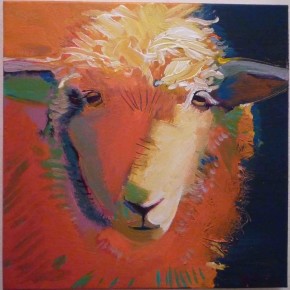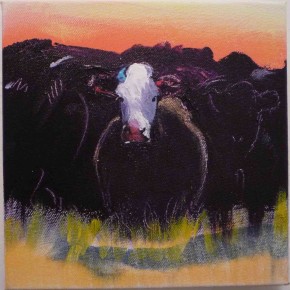
As a lover of wild places and wildlife I’m guessing over the years you’ve adopted lifestyle changes to reduce your carbon footprint on the earth. You turn off the water while brushing your teeth, you take shorter showers, you recycle, you drive less or own a hybrid or electric vehicle, you carry your own bag to the grocery store, you consume less than you used to.
If that’s you, then you will be amazed to hear that while all of those are admirable and helpful actions to reduce your carbon footprint, there is new data to prove that they pale in comparison to the ONE thing I’m going to tell you about today.
As you will learn by reading this post in it’s entirety, the ramifications of this ONE thing are so far-reaching that it will create a sea (and land) change for the earth. In fact, you will see why this ONE thing is our HOPE for saving the earth.
~~~~~
A few months ago the International Affairs think-tank, Chatham House, released a study that concluded “it is unlikely global temperature rises can be kept below two degrees Celsius without a radical shift in global meat and dairy consumption.”
We now know that animal agriculture (the meat and dairy industry) is the primary driving cause of environmental degradation in the world. It requires tremendous amounts of the earth’s resources, making it the leading cause of climate change, forest destruction, and species extinction.
That’s right, the Leading Cause.
The shocking thing is that while all the other environmental issues pale in comparison to the environmental degradation, water consumption, and pollution caused by the cows, pigs, chickens, turkeys, and sheep we eat, there are very few environmentalists, conservationists, or climate change experts addressing the issue.

Take a look at some facts:
— Animal Agriculture is the #1 contributor of human caused greenhouse gases in the atmosphere. Cows alone produce 18% of the world’s greenhouse gases. That’s more all the cars, trucks, and planes on the planet produce. (Combined, our vehicles produce 13% of the world’s greenhouse gases.)
— Methane, the gas produced by livestock, is more destructive then Carbon Dioxide, the gases produced by cars. Methane stays in the atmosphere for about 10 years, while Carbon Dioxide is in the environment for over 100 years.
IT’S NOT ABOUT TAKING SHORTER SHOWERS
–Private homes use 5. 5% of all the water consumed in the US.
–Animal Agriculture uses 55% (34 trillion gallons) of all the water consumed in the US.
— One hamburger requires 660 gallons of water to produce – the equivalent of 2 months worth of showers.
— That 1-gallon carton of milk in your refrigerator required 1,000 gallons of water to produce.
— The meat and dairy industries combined use nearly 1/3 of all the fresh water in the world today.
WHERE HAVE ALL THE WILD PLACES GONE?
–Livestock currently takes up 45% (and growing) of the earth’s total land mass. Humans and our animals (livestock) take up 98% of the earth, leaving only 2% for wild places and wildlife. We have stolen the earth’s wildness for humans and our factory farms.
— Ranchers are allowed to graze livestock on public lands and the government removes the wild horses, burros, coyotes, mountain lions, wolves, prarie dogs, and any other wild competition to the livestock’s water and food.
–According to the United Nations, animal agriculture is the leading cause of habitat destruction and species extinction in the rainforest. An estimated 91% of the destruction of the Amazon rainforests is due to land being cleared to raise livestock and grow soy and corn to feed those animals.
–136 million rainforest acres have been cleared for animal agriculture compared to 26 million rainforest acres which have been cleared for palm oil production.
–1/3 of the planet has turned to desert, and livestock is the leading cause.
–30% of the Earth’s entire land surface is used by the livestock sector.
Nearly half of the contiguous US is devoted to animal agriculture.
TOXIC UNTREATED WASTE
A farm with 2,500 dairy cows produces the same amount of waste as a city of 411,000 people.
The important difference is the human waste is treated before being discharged into the environment, but animal waste is not treated at all or minimally treated.
Animal waste run off has caused dead zones in our rivers and oceans, and rendered vast areas of land near the factory farms uninhabitable due to the stench and toxic soil and gases produced.
HOW MUCH MEAT DO WE EAT?
–There are 70 billion farmed animals reared annually worldwide.
–More than 6 million animals are killed for food every hour.
–Americans eat 9 oz / day / person of meat. We are the world’s third largest consumers of meat after China (#1) and Europe (#2).
IS GRASS-FED BEEF THE SOLUTION?
For years I’ve been adamant about choosing only grass-fed, free-range, pasture-raised animal products with the belief I was reducing my carbon footprint.
Was I right?
–Grass-fed beef produces 400’xs more methane than traditionally raised cows because the animals are killed after 22 months vs 15 months for grain fed. Pasture-raised, grass-fed cows also require a lot more land per cow.
–If every person in America switched to eating only grass-fed beef we would need to convert all of the land in the entire US into livestock grazing land. That’s right, all the land in the entire country.

DO WE HAVE A CHOICE?
I know the facts I’ve given you here may be overwhelming, depressing, and shocking. And for many of you, reducing and finally eliminating your animal food consumption may require drastic changes to your diet.
But I hope the facts have also given you hope.
Hope in knowing that by making this one lifestyle change to avoid animal products, you can truly alter the carbon footprint currently destroying our wild places and wildlife. You really can be the change you want to see happen.
PLEASE SHARE THIS WIDELY USING THE BUTTONS ON THE LEFT AND BOTTOM OF THIS POST. THE EARTH IS COUNTING ON YOU.
To see more of Susan Shapiro’s amazing paintings like the one of the cow featured in this post please visit her site, Susan Shapiro Fine Art.
9 Replies to “The Carbon Footprint That Trumps All Others”
Comments are closed.


Great post, Lori. Fantastic research that really drives home how cows are worse than cars. That’s also the title of an essay I’ve taught before. It’s by Ben Adler and it’s called “Are Cows Worse Than Cars?” I show Food Inc. to my class as well. I was a vegetarian for 20 years, but I struggle with giving up meat completely these days. Adler’s essay argues that if all Americans just cut back their meat intake by 10% we’d see huge changes. Anyhow, thanks for such an important message and hope you are well!
HI Cynthia. Thanks for your comments. I will look into that article. I was a vegetarian as well for 12 years then was only eating grass fed pasture raised animals until I learned what I wrote about in the post. Now I am back to not eating meat except maybe once a month if that. I have heard that to be sustainable humans can eat 2 oz a week. We now eat more than that at every meal. So, cutting back as much as we all can is really the answer. But make it a big cut back. Something that pushes your comfort level. We don’t have the luxury of taking small steps anymore if we really want to see change.
Astonishing and important information. Thanks for gathering it.
Agreed 100% and have not eaten meat in years mainly for the animal’s sake but now this makes it even more significant. I do know certain groups such as Mercy for Animals and others have been trying to get this out there for some time now. Meat eating is such an engrained daily habit and I wish there was some way to get the point across to greater numbers of people, most of whom seem completely oblivious as to where their McDonalds hamburgers even come from!
You’re right Lori. These facts are “over whelming, depressing and shocking”. But that’s what it takes, I guess, to get through an established mind set. Through the years I have been slowly decreasing the amount of meat and dairy products I eat due to articles and information such as your. Progress is slow but don’t give up is my motto. Keep up the good work!
Thanks Bev. Good job for decreasing your consumption. It is determined that to be sustainable we can eat 2 oz of meat a week. I have stopped eating meat altogether. These poor farm animals have the worst lives and I just can’t support it.
I am surprised at how extensive the impact is from raising livestock. I became a vegetarian for health 5 years ago and continue out of conscience. Now it will be for earth. I would like share this information and to point to the sources of these remarkable facts. Can you direct me where to reference the data?
Hi Shelia,
Yes, you can certainly share the info and this post. Please do.
The facts surprised me too, and were gathered from different sources over a period of a couple of months. But you can find a comprehensive overview at the website for the movie COWSPIRACY. Hope that helps. Thanks for commenting. Love to hear from readers.
Great post on earth day – did all your amazing facts come from the Chatham House report? If not, where?
Good job. Thanks.